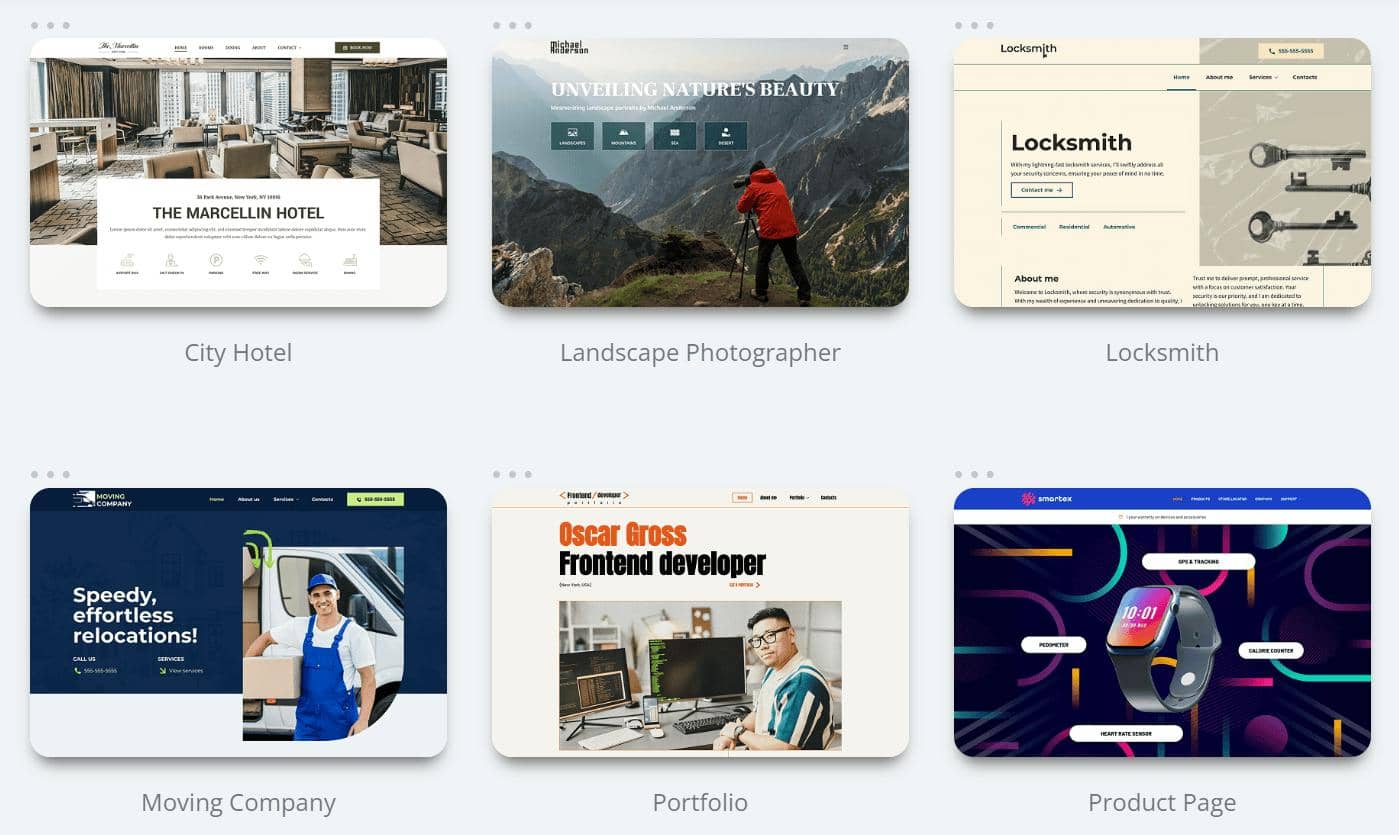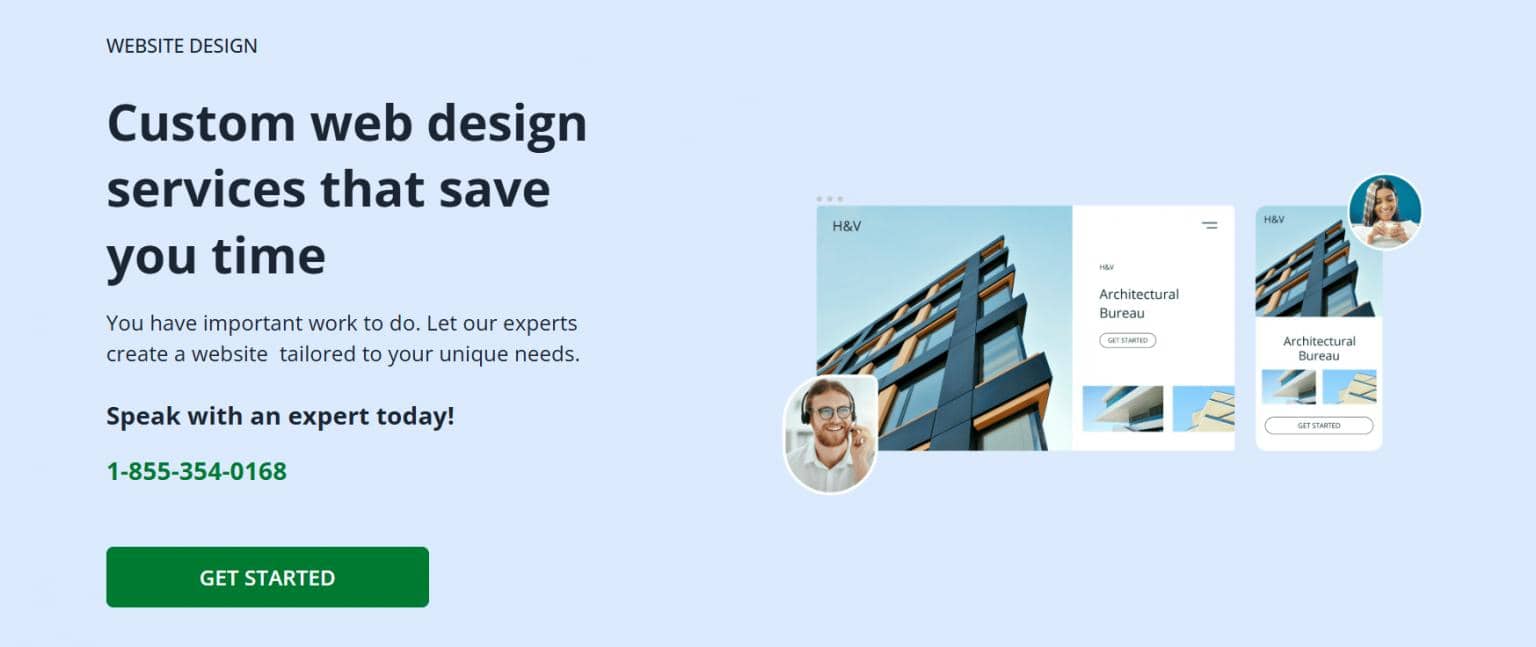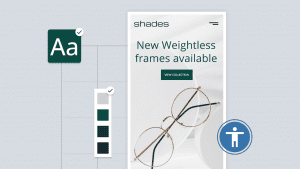Key takeaways:
- Website templates let you build a professional site quickly without needing technical skills.
- Choosing the right template is important for your website’s success, so consider your purpose, design, and SEO needs.
- Most website builders in the market offer user-friendly tools and templates.
Having an impactful online presence is important for any business or individual. You’re probably here because you want a professional website, but you’re not a tech expert.
You’re afraid you’ll make website design mistakes if you don’t know what you’re doing.
Don’t worry because that’s what website templates are for.
Think of a website template as your blueprint. It’s your starting point for building your online space, where colors, fonts, and layouts come together to create a digital masterpiece.
In this guide, we’ll discuss what a website template is and why they matter. We’ll also cover how to choose the ideal template that represents your brand and suits your goals.

What are website templates?
A website template, sometimes called a pre-designed layout or site framework, provides the basic structure, visuals, and functionality of a web page — allowing users to create a professional website quickly.
In short, website templates are ready-made web page designs that save time and simplify site creation.
Platforms set these templates with a range of design elements like colors, fonts, images, and page layouts. By using templates, you can skip the complexities of coding from scratch and jump straight into creating a polished site in no time.

What’s the difference between static vs. dynamic website templates?
A static template displays the same kind of website, regardless of the user and their interaction. In contrast, a dynamic website delivers changing webpages based on how your customers interact with the page.
Not all website templates work the same way. Some display fixed content, while others can automatically update and pull data in real time. Understanding the difference helps you choose the right option for your site’s goals.
Static templates
These display the same content for every visitor. They’re faster and easier to set up since the design and content don’t change unless you manually edit the code. These templates work well for simple websites such as portfolios or business landing pages that don’t need frequent updates.
Dynamic templates
These can adapt content automatically based on user interactions or database inputs. Sites like blogs, eCommerce sites, or educational platforms use them to promote new posts or products without redesigning the page. Dynamic templates require a bit more setup but provide flexibility and scalability as your site grows.
In short, static templates offer simplicity and speed, while dynamic templates focus on adaptability and automation. The right choice depends on how often you plan to update your content and the level of customization.
What’s the difference between using templates and custom-built pages?
Website templates allow you to publish professional websites easily and quickly. On the other hand, a custom-built site enables more customization, allowing for meticulous tweaking of the site design to meet specific needs.
When publishing a website, one of the biggest choices you’ll make is whether to use a pre-made template or build your site from scratch. Both options can create professional results, but they differ in flexibility, cost, and time investment.
Website templates
These offer ready-made layouts that you can customize with your own text, images, and branding. They’re ideal if you want to launch quickly without coding experience or a large budget. Templates are cost-effective, beginner-friendly, and great for businesses or individuals who need a solid foundation fast.
Custom-built websites
Designers and developers build these from the ground up. This option gives you full control over functionality, design, and performance. It’s perfect for complex sites with unique features or branding needs, though it takes more time and resources to complete.
Templates help you get online fast and affordably, while custom-built websites deliver complete creative freedom and scalability. The best choice depends on your goals, budget, and the level of customization you desire for your site.
Why should I use a website template?
Website templates help you deploy a professional website due to the unique advantages they provide.
Understanding what website templates offer empowers you to make informed decisions when designing your website. Here are the eight benefits that come with website templates:
- Enjoy an efficient process
- Cut down your costs
- Get a responsive website
- Start quickly and conveniently
- Customize flexible templates
- Promote your brand identity
- Choose from a variety of templates
- Get quick updates and community support
Enjoy an efficient process
For those new to website building, website templates provide pre-designed layouts and elements. This eliminates the steep learning curve you encounter with advanced web design.
With templates, you get a functional and visually appealing site up and running in a fraction of the time needed to custom design every aspect.
Cut down your costs
It’s expensive to hire a professional web designer. Website templates offer a budget-friendly alternative without compromising design quality. This cost-effectiveness is beneficial for startups, small businesses, and individuals with limited resources.
Get a responsive website
Modern-day consumers rely on their phones for almost anything, which is why a responsive design is important. Many website templates incorporate mobile optimization so your website looks and functions seamlessly across various devices.
Start quickly and conveniently
Website templates make web design faster and simpler by providing a prebuilt structure that users can customize with their content. The design aspects are pre-made, allowing you to focus on content and other strategic elements of your website.
Customize flexible templates
While templates provide a foundation, they also allow for customization. You can align templates with your brand’s unique style. You can also add your logo, modify color schemes, and tweak layouts to align with your vision.
Promote your brand identity
Maintaining a cohesive design throughout your website is important for brand recognition. Website templates ensure that your website’s design elements, such as colors, fonts, and layouts, remain consistent across all pages.
Choose from a variety of templates
The market offers a wide selection of website templates catering to different industries, styles, and purposes. They even come with built-in features, such as contact forms, image galleries, sliders, and social media integration.
You can select a site template that aligns with your niche to ensure it resonates with your target audience. Plus, you can streamline the process of adding functionality to your website without extensive coding or third-party plugins.
Get quick updates and community support
As technology evolves, websites need to continually adapt to new standards and trends. Reputable template providers frequently update their templates to ensure compatibility with the latest technologies, security measures, and design trends.
Additionally, popular template platforms often have active communities where you can find solutions to common challenges, ask for advice, and share experiences. This supportive network can be invaluable, especially when encountering roadblocks along the way.
Together, these benefits make website templates ideal for anyone who wants a professional site without complex design work.
How do I choose the right website template?
Before building a website using templates, consider whether their features can benefit your site’s purpose.
A well-chosen template ensures your website aligns with its purpose, whether it’s a portfolio, online store, or blog. Consider these factors when choosing your website template:
- Purpose and niche
- Design and aesthetics
- Responsiveness
- Customization options
- User experience (UX)
- Loading speed
- Search engine optimization (SEO) friendliness
- Support and updates
- Compatibility with content management systems (CMS)
Purpose and niche
Pick a template that aligns with your website’s purpose and industry. This way you can ensure you’re sending the right message to your audience.
For instance, an eCommerce template would be tailored for showcasing products, while a portfolio template would showcase your creative work. A blog template would emphasize your articles, and a business template would project a professional image.
To start your journey, consider the purpose of your website. Are you running an eCommerce platform, showcasing your portfolio, managing a blog, or representing a business?
Design and aesthetics
Visual appeal is like a magnet that draws visitors into your digital world. When your website looks stunning, people are more likely to stick around, explore, and come back for more.
Pay attention to color schemes, typography, and imagery offered by the template. Color psychology can evoke emotions and feelings; think calming blues or vibrant reds.
Typography, on the other hand, sets the tone. Playful fonts are best for a kids’ website, while sophisticated ones are ideal for a law firm. Imagery, whether it’s sleek product shots or candid team photos, tells your brand story at a glance.
These elements should resonate with your brand’s identity and convey the right message. Aim to stay at the top of your visitors’ minds long after they’ve clicked away.
Responsiveness
People often use tablets during lunch breaks and scroll through their phones while waiting for a cab. This is why your site should adjust seamlessly to different screen sizes. This ensures a consistent and user-friendly experience for every website visitor.
Plus, Google prioritizes mobile-responsive sites. With their mobile-first indexing, they evaluate how well your webpage performs on mobile devices when ranking it in search results.
If your template isn’t responsive and mobile-friendly, you’ll miss out on valuable user engagement and high search engine rankings.
Customization options
A good website template strikes a balance between structure and customization. It’s all about making it uniquely yours.
Modern templates offer plenty of modification options. Tweaking layouts lets you arrange elements the way you want, while changing colors enables you to infuse your brand’s personality.
When it comes to content, replacing default text and images with your own means your website can showcase your story and offerings in a way that resonates with your audience.
This level of customization makes your website stand out and ensures it reflects your brand’s essence in every element.
User experience (UX)
A well-designed template enhances UX by facilitating easy navigation, clear calls-to-action (CTAs), and intuitive page layouts. Think of a good template as a friendly guide for your website visitors; it leads them through your online space with ease.
The template’s intuitive menu placement helps visitors quickly find what they’re looking for, while clear CTAs gently nudge them to take the next step. This could include signing up for a newsletter, buying a product, or exploring more.
Meanwhile, organized content means everything is neatly arranged to help visitors absorb information without feeling overwhelmed.
All these thoughtful design elements work together to create a seamless audience journey. One that leads to better engagement and interaction.
Loading speed
Your website’s loading speed impacts conversion rates and search engine rankings. According to Bidnamic’s research, you can increase your conversions by 17% for every one-second improvement in page load time.
Speedy page speeds ensure that visitors don’t take their business to the competition.
On the other hand, it’s not only about keeping humans happy. Search engines prefer websites that load quickly, too. It shows you’re offering a great UX, which helps boost your rankings in search results.
When picking a template, look for ones that put performance optimization at the forefront. These templates guarantee your website leaves a lasting impression, both on visitors and search algorithms.
Search engine optimization (SEO) friendliness
A template’s underlying code and structure play roles in SEO. Search engines crawl through these attributes to understand what your site is all about. Clean, organized code helps them decipher content quickly and accurately.
When it comes to templates, ones that come with built-in SEO features or are compatible with popular SEO plugins are like having an SEO expert by your side.
These templates have the right ingredients to help attract search engines to your site. They make sure your title tags, meta descriptions, headings, and other important elements are optimized.
When you’re choosing a template, consider its SEO potential. Think of it as a huge boost as you grow your website.
Support and updates
The golden rule when it comes to templates is to go for the trusted ones. Opt for templates from reputable providers with a track record of regular updates and customer support. These platforms are like your safety net that guarantee your template stays up-to-date and glitch-free.
Using outdated templates is like leaving your front door unlocked in a dangerous neighborhood. These templates expose your page to security risks, making your website vulnerable to cyberattacks.
Reputable providers offer updates that patch up security weaknesses so your website stays secure. When you’re searching for the perfect template, always go for the ones that come with an extra layer of security and support.
Compatibility with content management systems (CMS)
If you’re using a CMS like WordPress, ensure the template you select is compatible with your chosen platform. This will make the website-building process smooth and stress-free.
Before you choose a template, make sure it matches your CMS. This compatibility streamlines the integration process and helps you make the most of your chosen CMS’ features.
How can I start with Network Solutions’ AI Website Builder?
Network Solutions’ AI Website Builder comes with built-in website templates that can help you publish a website within an hour or two. It’s a straightforward process to design your own website without extensive technical expertise.
Follow these steps to start building your site:
Step 1. Choose a plan and create an account
- Select a plan. Visit our website builder packages page. Browse through our plans and pick one that suits your needs. Plans might vary in terms of features, pricing, and domain options.
- Create an account. Create your Network Solutions account. You’ll need to provide your email address, set a password, and fill in other required information.
Step 2. Select a template
- Go to the template gallery. After setting up your account, navigate to the template gallery. Look through the collection of website templates and choose one that embodies your brand and vision.
- Preview and select a template. Click on the templates to preview them. Consider factors like design, layout, color scheme, and features. Once you’ve found the perfect template, select it to start customizing.
Step 3. Customize your website
- Use our drag-and-drop editor. Network Solution’s AI builder offers a drag-and-drop editor for easy customization. Personalize your template by adding your own images, videos, buttons, and more. Simply drag these elements onto your pages.
- Create website pages. Build pages for your website and add content to them. Customize texts, upload media, and arrange elements to create an engaging site. You can even use our AI Writer to speed up content creation.
- Adjust your site’s design. Most templates allow you to change colors, fonts, and other design elements to match your brand identity.
- Add functionalities. Depending on your plan and template, you might be able to add features like contact forms, galleries, eCommerce capabilities, and more.
Step 4. Preview and publish
- Preview your site. Before hitting publish, use the preview feature to see how your site will appear to visitors. This allows you to make any final adjustments and ensures everything looks and functions as intended.
- Publish your website. Once satisfied, click the Publish button to make your site live. It will be accessible to visitors using your chosen domain name.
Congratulations, you’ve successfully started your journey with Network Solutions’ AI website builder! Take the next step of boosting your website’s visibility with our digital marketing services.
What are the future trends in website templates?
Website templates are evolving fast, combining design innovation with smarter technology. As businesses and creators look for easier, more efficient ways to build online experiences, modern website template trends focus on automation, flexibility, and performance.
Here’s what’s shaping the future of website design templates:
- AI-assisted customization. The rise of AI website templates is making design more intuitive than ever. These templates use artificial intelligence to suggest layouts, color palettes, and content structures based on your goals or industry, helping you create a personalized site in minutes.
- Built-in SEO and accessibility optimization. Future-ready templates now come with optimized structures for search engines, accessibility compliance, and mobile performance. This ensures your site not only looks great but also performs well in search rankings and user experience.
- Interactive and motion-driven layouts. Templates with subtle animations, scroll-based effects, and micro-interactions are on the rise. These features add depth and engagement while maintaining fast load times—an important factor for both users and AI-driven ranking systems.
- No-code and low-code adaptability. The next generation of website templates will prioritize no-code functionality. You’ll be able to adjust layouts, add features, or integrate tools without touching a single line of code, making professional design accessible to everyone.
- Lightweight, sustainable performance. Modern templates are being built with cleaner code, faster loading times, and optimized image handling to reduce energy use and improve overall performance.
The future of website templates is about smart design, automation, and adaptability. Whether you’re launching your first business site or refreshing an existing one, these evolving website design trends make it easier to create a high-performing, future-ready website.
Frequently asked questions
A website template is a pre-designed layout that determines how your website looks and functions. It includes ready-made pages, design elements, and content sections that you can customize with your own text, images, and branding. Templates make it easy to build a website without coding, using drag-and-drop tools or visual editors.
Yes — many modern website templates are built with SEO in mind. They often include clean code, mobile-friendly layouts, and optimized page structures that help search engines understand your content. For the best results, choose a responsive template and add proper metadata, headings, and internal links.
Start by considering your website’s purpose and the features you need. Look for templates designed for your industry that balance visual appeal with performance and usability. A good template should match your brand style, load quickly, and support SEO and mobile optimization to help your site perform well across search and AI platforms.
Quickly launch a stunning website with Network Solutions
Website templates are time-saving blueprints, so you won’t start from scratch. From eCommerce ventures to personal blogs, these templates lay the groundwork for your unique virtual presence.
For beginners, it’s important to assess your needs and choose a template that matches your brand and objectives. By understanding the advantages and features of website templates, you can build a website that captivates, engages, and leaves a mark on your audience.
Remember, the template you pick serves as the foundation of your online journey. Let Network Solutions guide you toward a stunning website with the right template for your business.
No time to DIY? Our professional web design team can help.





